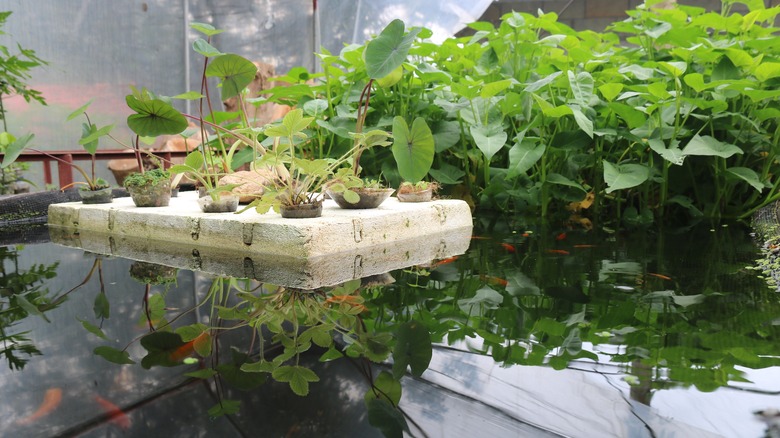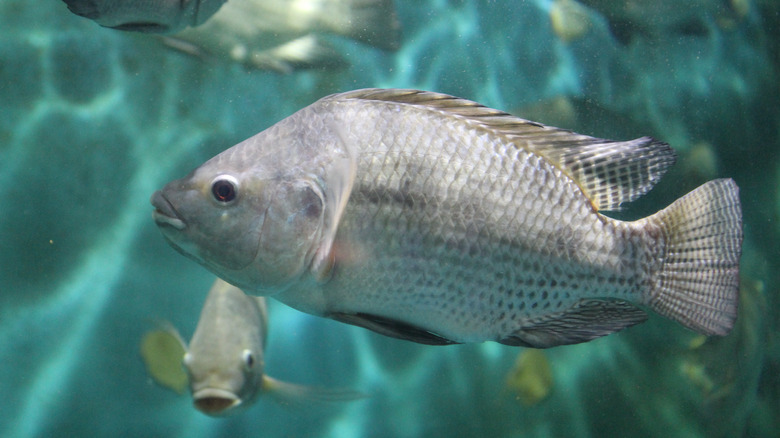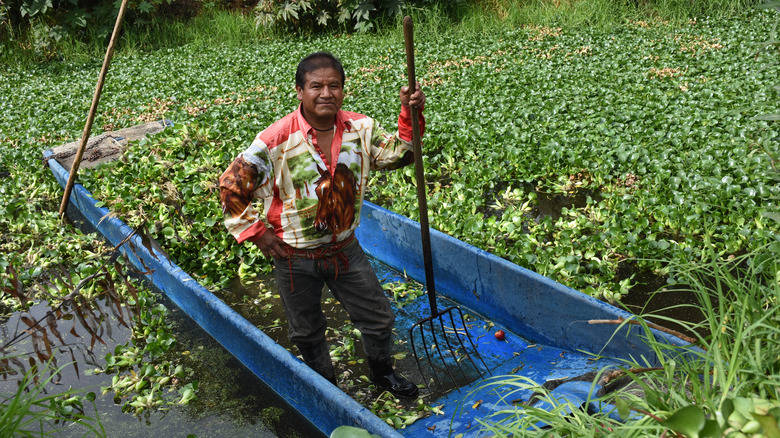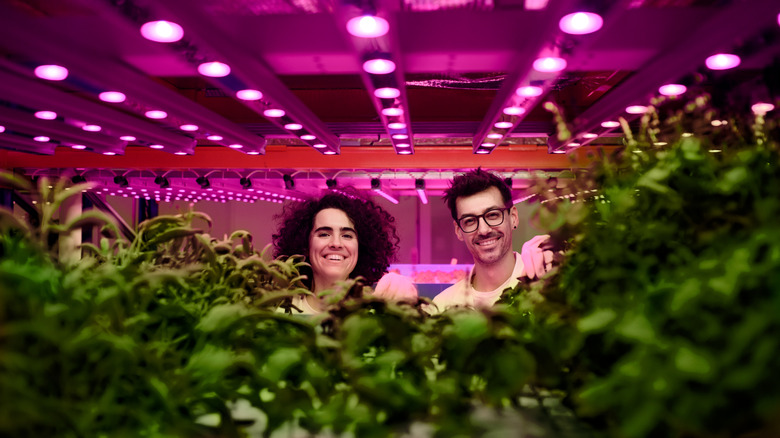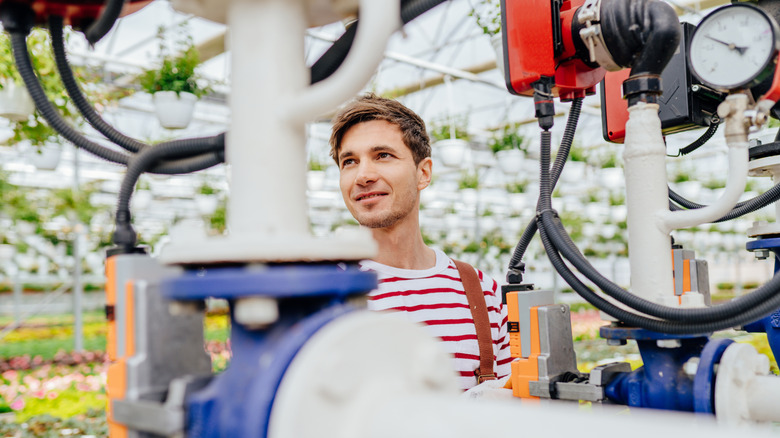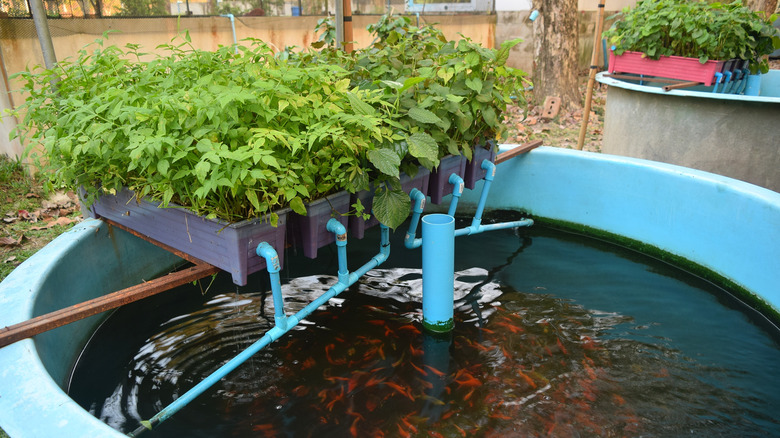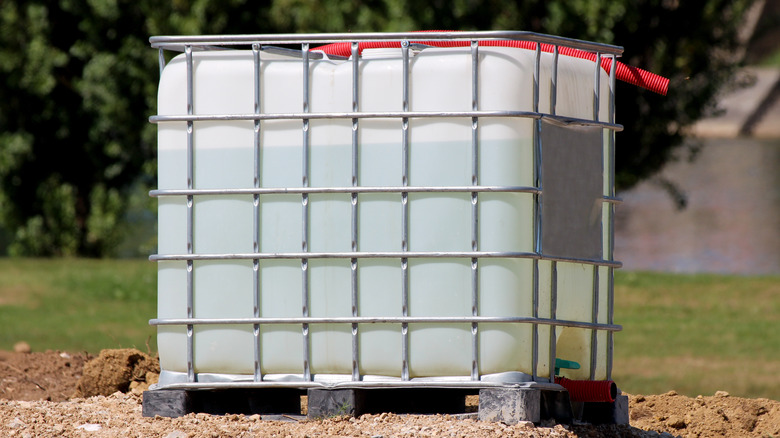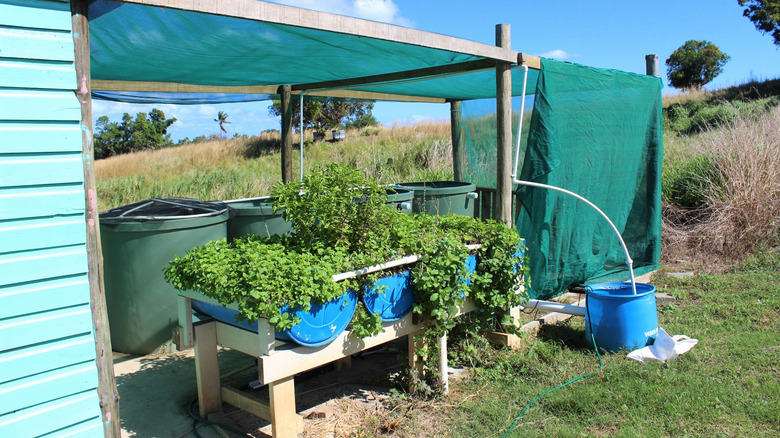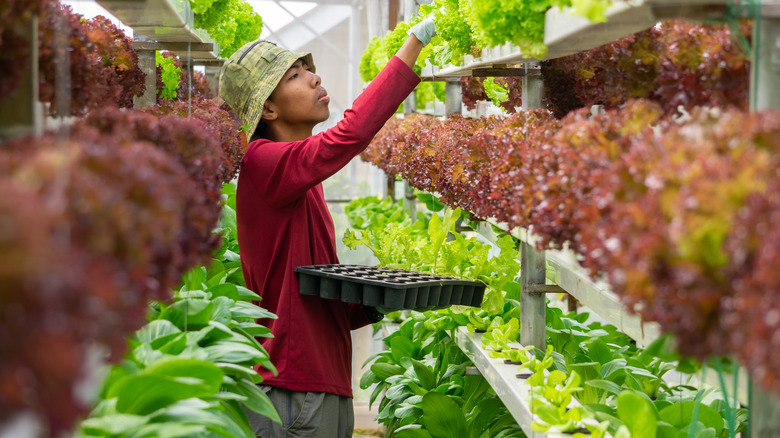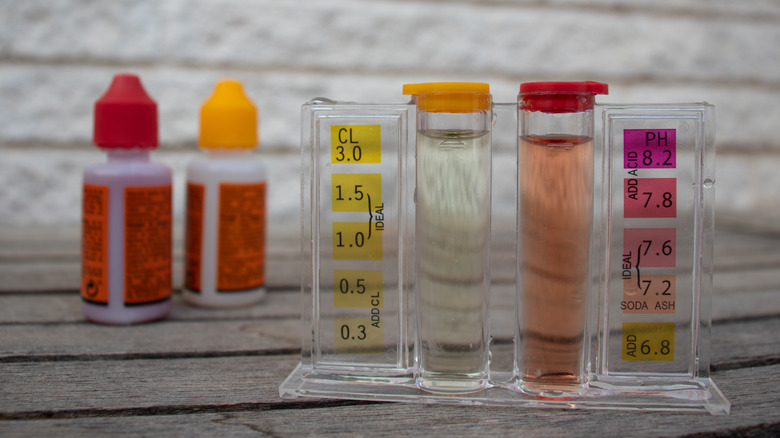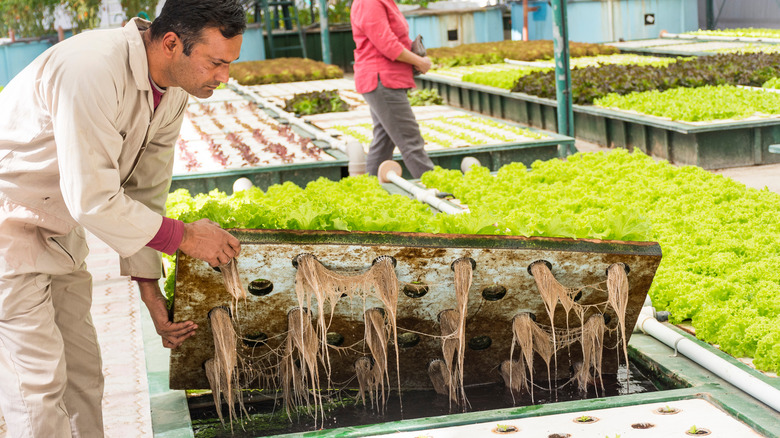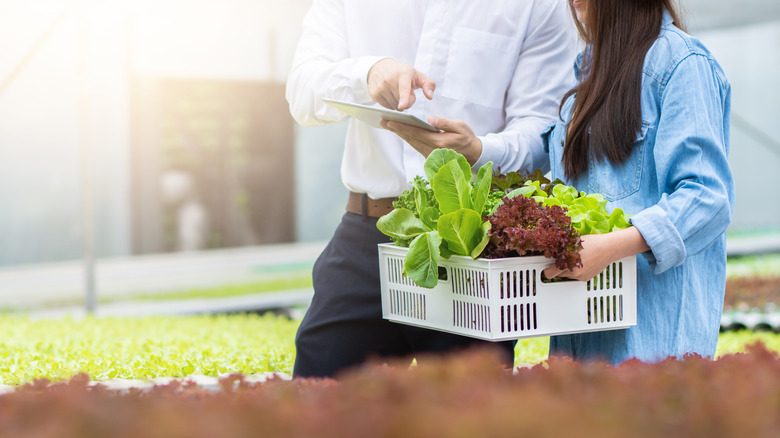What Is Aquaponic Gardening And How Do You Get Started?
What's better than growing a crop of vegetables from a water-based hydroponic gardening system? Raising fish to do the grunt work for you. That's right, aquaponics is all about setting up a gardening system in which fish live their normal lives — eating, pooping, and swimming — in a tank or man-made pond, and then all that fish poop acts as fertilizer for plants whose roots lie beneath the surface of the water. For a more technical definition, let's go to the Natural Agricultural Library. Per the U.S. Department of Agriculture, "Aquaponics is a combination of fish and plant production [aquaculture] and hydroponics (growing plants without soil)."
There is a symbiotic relationship at work within the system, explains Permaculture Research Institute. The fish feed the plants, allowing them to grow robust and plentiful. The plants then clean the water to keep the fish healthy. Beneficial bacteria, or microbes, represent the third leg of a symbiotic triangle. They help feed the plants by doing the conversion work of breaking down the fish waste (ammonia) into absorbable substances (nitrates) for the plants (via Eartheasy). Keep reading to learn all about this gardening system.
How is aquaponic gardening different than hydroponic gardening?
At first glance, the two systems can look very similar, but it's safe to say there's something fishy going on below the surface of the water. When it comes down to it, the primary difference between hydroponic and aquaponic gardening is in the fish. Hydroponics relies upon human intervention to create nutrient and fertilizer-enriched water to grow plants, while aquaponics employs fish for the job of fertilization (via excrement), and trusts that nature will balance out the nutrition on its own, explains Trees.com.
There are easy ways to DIY a hydroponic garden, but an aquaponic setup gets a little more complicated; you're no longer simply growing vegetables, after all, now you're also raising fish. Oh, the responsibility! Whether you're a pescatarian with plans to eat the fish you raise, or a vegetarian dead set on promising them their best life until nature decides their time is up, it's important to weigh the added liability and obligation of this type of fish-based gardening.
One more difference is that aquaponic systems are more water efficient than hydroponic systems. This is primarily because the water can be used for longer periods of time. In a hydroponic setup, all of the water needs to be flushed out and replaced every three months, whereas with an aquaponic setup, this only needs to happen once per year.
History of aquaponics
Historically speaking, the practice of aquaponics appeared on record in China in 500 B.C. when a politician named Fan Lee wrote about it in a detailed study titled, "The Chinese Fish Culture Classic" (via Food and Agriculture Organization of the United Nations). Even farther back, around 2000 B.C., anthropological research suggests that many cultures were relying on the combination of aquaculture and hydroponics for sustenance, including those from China, Egypt, Japan, Peru, Greece, and, of course, the Aztecs, notes University of Washington.
By the 12th century A.D., farmers in China were homing in on best practices regarding disease control, the structure of their ponds, and the ideal amount of fish per system. At the same, across the world in Mexico, the Aztecs were experimenting with man-made islands called chinampas. Farmers would fence off an area inside a shallow lake bed and build an artificial island — which basically became a floating raft — by layering the area with mud, sediment, and decaying plant matter. The top of a chinampa was typically about a meter above the surface of the lake. Corn, beans, squash, chili peppers, tomatoes, and more would grow on each island with roots stretching down into the water. The natural ecosystem of the lake took care of fertilization needs and the resulting food was used to feed the people of Tenochtitlán. Throughout the 1400s, aquaponic farming made its way to Indonesia, Malaysia, Thailand, and beyond.
Is aquaponic gardening right for you?
If you live in area with particularly nutrient-deficient, poor quality soil, or if you simply don't have access to yard space at all, the ancient system of aquaponic farming could be a great option for you. But just because a process has been in existence for thousands of years doesn't mean it's going to fit neatly into your modern day lifestyle. To begin with, Environment.co points to a significant increase in energy costs to run the filtration system. This may not be an issue if you have access to a renewable form of energy like solar panels, but for those who rely entirely on the electric company for power, those costs could run up fast.
While the fish do the work of feeding the plants, the system itself requires regular attention. This isn't something you're going to set up and walk away from, only to return weeks later to a garden flush with vegetables. Permaculture Research Institute warns that, even though they may seem like their own natural ecosystems, these gardens are man-made and maintained by us. A commitment to this endeavor requires a daily chunk of time.
In the end, you might realize that your favorite thing about gardening is the ritual of plunging your hands into the soil and inhaling the pungent scent of the earth. Digging in the dirt is a beautiful reason to become a gardener. Now consider for a moment the fishy scent of recirculating pond water you'll encounter instead as you tend to your aquaponic crops. We don't meant to scare you off, but in order to know if aquaponic gardening is right for you, you've got to understand the space and water requirements, as well as the equipment involved.
Space requirements for aquaponic gardening
An aquaponic system can be as small and basic as a $15 jar on the kitchen counter that's home to a betta fish below, and the plant of your choice up above. Or, it can be as massive as a 200 gallon fish tank with a 4-foot by 8-foot grow bed, which will run you a cool $8,500, per Greenhouse Megastore. That's all to say, you can find something appropriate no matter how little or how much space you have.
Ultimately, the amount of space your system will take up is dependent upon what and how much you want to grow, advises Gardential. From there, you'll need to make sure the size of your fish tank is proportionate to the intended size of your grow bed(s). The fish will also need to be the right size for the tank you choose — a small desktop aquarium will not be big enough to house the 5 pound Nile tilapia you're hoping to raise for an eventual feast. Gardential notes two ways to calculate your optimal fish to water ratio. For ornamental fish, go with 5 gallons of water for each individual fish. To raise fish as an additional food crop, bring the ratio down to 1 pound of fish per 3 gallons of tank space/water.
For the highest incidence of success, How To Aquaponic offers the handy reminder of making sure the area is easily accessible and flooded with natural sunlight. And don't forget you'll need direct access to a water source and electricity — no daisy chaining extension cords together, especially considering the risk of shock or worse when you have electricity and water working hand in hand.
Water requirements for aquaponic gardening
Another name for an aquaponic farming setup is a recirculating aquaculture system, or RAS. Because the operation is made up of a closed loop, the water contained inside is constantly cleaned and reused. This makes it a very sustainable method of farming, using 10% or less of the amount of water used in standard agricultural operations. Furthermore, an RAS lacks the contaminated waste water associated with soil-based farms.
The fact that you're dealing with a large tank of water may make it seem like a lot more than what you're used to seeing drip out of your irrigation hoses, but the reality is that it's considerably less. Symbi Biological broke down how much water it takes to grow a single head of lettuce in an RAS system (2 gallons) versus a field (16 gallons). When multiplied by the 300 heads of lettuce they can actually produce, those numbers leap to 600 gallons for the aquaponics system and 4,224 gallons to grow the same amount of lettuce in the dirt. Suddenly, you can see the drastic difference in usage.
Food & Water Watch adds the reminder that the whole time you're growing vegetables with considerably less water, you're also raising a crop of fish. What soil-based gardener can beat that? Recirculating water within an aquaponic system creates a clean and ecologically sustainable environment.
Equipment requirements for aquaponic gardening
Equipment requirements will vary depending on the size of your system. Starting with the most important aspect —the fish tank (without which aquaponics would be impossible) — you'll also need a water pump, an air pump, and PVC piping with fittings. If you're a super-DIYer, it's possible to build your own tank from scratch, but, obviously, this will result in a major time-consuming project. To the new DIYer keen on avoiding mistakes at the starting line, we say, let this be the easy part. How To Aquaponic suggests purchasing or scavenging secondhand websites for a non-toxic, food-grade intermediate bulk container, also called an IBC tote and pictured above.
Regarding the growing of plants, you'll need a grow bed, growing media, rockwool seed starting cubes, and a seed starting tray (via How To Aquaponic). Per Farming Aquaponics, you've got plenty of choices to make in this arena, and a little education will go a long way. A growing medium is essentially a stand-in for soil, offering protection and structural support for plant roots. There are organic and synthetic options available, including clay pebbles, lava rocks, expanded shale, and coconut coir. Clay pebbles are considered the best option, though certainly not the least expensive. Ultimately, your choices will depend on your budget, the type of plants you want to grow, and personal preferences. There will be a water testing kit on your shopping list for managing pH levels (more on that below). How To Aquaponic mentions that an electrical conductivity (EC) or total dissolved salts (TDS) meter will come in handy, as well as uniseals, bulkheads, and a siphon too.
How to set up an aquaponic gardening system
If you've made it this far into the article, we can assume you feel confident that this is for you. Here's how to begin setting up your at-home system. Eartheasy advises that the first step is to construct your tank and dechlorinate the water inside by letting the pumps run it through the filtration system for 4 to 6 weeks. Next, you'll put together your media bed, also called a flood table, next to or above the tank — this is where the plants will grow. Make sure the structure holding the media bed is sufficiently sturdy, then fill it with your choice of growing media (clay pebbles, coconut coir, etc.).
Once your tank and grow bed are set up and bacteria has had a chance to build up in the water, it'll be time to introduce the fish to their new environment. The most common fish are tilapia, goldfish, and koi. Tilapia are considered the easiest to raise and care for, but goldfish are known to produce the most waste — i.e. food for your hungry plants.
Speaking of plants, your seedlings are the final component to your initial aquaponic garden setup. Eartheasy notes that leafy vegetables are indeed the easiest to grow aquaponically, so for the sake of encouraging early success, you might consider starting with lettuce, basil, or kale. Carefully situate seedling roots in the clay pebbles so that they touch the water and will be able to suck up the nutrients they need to grow.
What plants should you grow in your aquaponic garden?
We know leafy vegetables do great, but what else can you grow? Whether you want to focus on vegetables or flowers, there's a wide range of plants that are perfect for aquaponics. Tomatoes and cucumbers rank high on the list for the plants that will easily thrive in this type of garden, but really most of the standard backyard garden vegetables will do great, says How To Aquaponic. Herbs like ginger and basil are perfect options, as are peppers, onions, beets, chard, orchids, and so much more.
Considering plants in an aquaponic system tend to grow faster and offer a higher yield of fruits and vegetables, your biggest decision might be figuring out what you don't want too much of, and then sticking to a single plant. You've only got so much room in the pantry for jars of spaghetti sauce, right? Mint, in particular, will grow at a mind-boggling rate to the point of becoming invasive and choking out its neighbors. One farmer took to the Backyard Aquaponics forum to say they're having such a difficult time containing their mint crop that they're going to pull out the roots and have a bonfire. Consider yourself warned!
Of course, not everything will appreciate the aquaponic lifestyle. There are some plants that are better left in the soil, because they have very specific pH requirements, which are difficult to maintain in the water of an aquaponic system. How To Aquaponic explains that these include blueberries (which prefer a low pH) and chrysanthemums (which want a high pH). So, what's the deal with pH? We were just about to get into that.
Maintaining proper pH levels in your aquaponic garden
Water quality is a crucial aspect of aquaponic gardening that cannot be overlooked because it's essential to keeping your fish healthy. New Mexico State University notes that the source of your water (be it well, municipal, or surface water) will affect its quality. For example, standard tap water will contain chlorine that must be filtered out before the water becomes usable for farming.
Per World Water Reserve, the pH of your water concerns the concentration of hydrogen ions, which basically tells you if the water is neutral (7), basic (higher than 7), or acidic (lower than 7). These pH levels can affect everything from the health of your fish to the plants' ability to absorb nutrients — it even affects those hard-working bacteria. In order to know the optimal range of pH for your system, you'll need to understand the needs of your fish. This range usually leans alkaline (basic) — falling within the 6.5 to 9.0 range —and it will depend on whether you have fresh or saltwater stock. Bacteria also like to on the slightly alkaline side of the scale.
Meanwhile, plants tend to thrive in a slightly acidic environment. When the three come together to live in symbiosis, the optimal pH range narrows to between 6.5 to 7.5, in order to keep everyone happy. To maintain these levels, you'll need to regularly test your water with a pH kit. Go Green Aquaponics explains that there are various ways to adjust the pH either up or down when needed. Do so gradually, so as not to shock or potentially harm the fish.
Best practices for aquaponic gardening
There are some key guidelines sure to keep you on track with a successfully-running aquaponic system, according to the Food and Agriculture Organization of the United Nations (FAO). First of all, take your time when deciding on a fish tank. Among the most durable options are fiberglass and inert plastic, such as Polyethylene and Polypropylene, which will not become corroded, explains Filson Filters. Regarding shape, FAO advises that it's easier to clean circular tanks.
The water needs to contain dissolved oxygen and it needs to be in constant motion to ensure healthy fish and bacteria. (It's also better for the plants!) For these reasons, air pumps for proper aeration and water pumps for circulation are essential. Think of the water as the lungs of the system — everything living within it (fish, plants, bacteria, etc.) depend on high-quality water, just as humans depend on air. In regard to water quality, FAO lists dissolved oxygen, pH levels, temperature, total nitrogen, and water alkalinity as the key factors to keep in check.
Don't overdo it with the fish; keep your total quantity to a manageable number. Any time you see uneaten fish food waste, remove it from the water before it can rot and harm the overall ecosystem, and then cut back how much food you disperse the next day. Finally, plot your grow beds just as you would your backyard garden. Do your research so you know in advance which vegetables grow well near each other, and consider how long each crop will take to seed, germinate, and grow to harvest. FAO notes the importance of always having a supply a young fish as well as young plants.
Where to go for help with aquaponic gardening
Aquaponic gardening is certainly on the rise, but it has yet to become a mainstream way to grow flowers, fruits, and vegetables. We get it if you feel like you're in this alone, so we'd like to offer some ideas for researching and finding more of the detailed information you need. The Association of Food & Drug Officials is the first place to go for information regarding laws, regulations, and permit requirements for your state. Even though the focus is on aquaculture specifically, you'll want to check these out before you get started with aquaponics.
Once you get the regulations for your area worked out, head over to Rob Bob's Aquaponics and Backyard Farm. With over 40 million views and counting, this Australia-based YouTube channel offers a free and thorough education, with videos about every aspect of aquaponic farming. A few other excellent resources include Go Green Aquaponics, which we've cited above; Aquaponics DIYer, a website run by a professional aquaponics gardener keen on teaching DIYers everything they need to know; The Aquarium Adviser, which has a blog dedicated to aquaponics; and Aquaponics For Beginners, a website intentionally designed to act as an information hub on the topic.
If we've still got your attention, you likely have a strong feeling that aquaponic gardening is the way for you to go. Dip in a toe or plunge yourself into the deep end. Either way, try to have fun and remember that you're making a wonderful choice for your health and that of everyone who consumes your food, as well as the planet!
